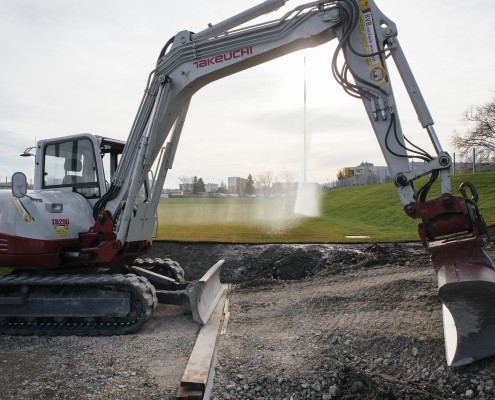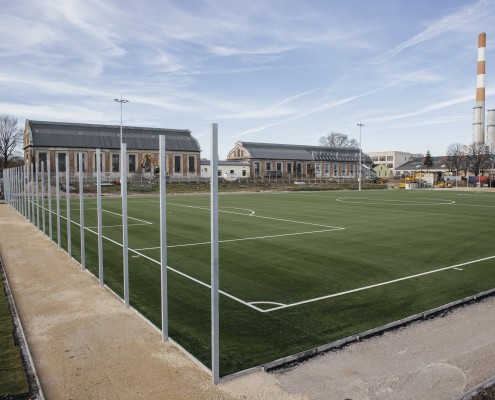The Vienna Sewer expands Europe’s most modern waste water sewer in Simmering. The two storage canals and the subterranean storage basin started its test operation in February 2016.
Vienna’s sewer is expanding Europe’s most modern waste water system in Simmering. Both collection sewers and the spectacular underground storage basin went into trial operation in the middle of February 2016.
“Before water looks for its way, we build it”. From 2013 to 2016, the Vienna sewer worked on Europe’s biggest sewer construction site based on this motto. Despite global climate change, increasing extreme weather events and the associated heavy rains, a gigantic storage basin and two upstream transport sewers keep the 11th Community District of Vienna dry. The “concrete tub” is 90 meters long, 45 meters wide and seven meters deep.
In combination with the new storage basin, the two sewers “Unter der Kirche” and “Florian-Hedorfer-Strasse” protect the 11th District from flooding during extreme rain. The EUR 30 million underground construction projects can hold up to 34 million liters of rain water. The water is stored temporarily and then directed to the main wastewater treatment plant in Simmering once the rain event has passed and the storm sewers have capacity.
The ball rolls above the ground, the water flows below
The planning office located the ideal location for the underground storage basin below the sports center of the SC Mautner Markhof. As part of the sewer construction measures, the sports center of the SC Mautner Markhof at Haidestraße 10 was also renovated.
“The future storage basin at Haidestraße 10 and the two transport sewers are the final components of the rainwater storing system in and around the 11th district holding a total of 86 million liters.” The director of Vienna’s sewers, Andreas Ilmer said, “We thus react to the consequences of climate change that has long been discernible by us, which causes extreme weather events and rainfalls.”
Flooding protection beyond the district limits
A total of 20 square kilometers and three districts fall into the area of consideration for flood protection for Simmering. When there is precipitation, the Liesingtal plays a significant role as a large volume of combined wastewater flows from there to the main wastewater treatment plant in Simmering. For this reason, it was important to technicians at the administration office of Vienna’s sewers to also take measures toward retention at the “source”. The former Blumental treatment plant in the 23rd district provided an outstanding option as a storage basin. Since 2012, an additional 20 million liters of storage volume is available for retention and it can be filled with 3,000 liters per second in the event of rain. This relieves the burden on the sewer system in Simmering in the event of heavy rainfall and increases protection from flooding.
The expansion of the Kaiserebersdorf wastewater pump station was an additional important component to optimizing the protection from flooding in Simmering. An additional spiral pump increased the pumping capacity by 1,300 liters bringing it up to 6,700 liters per second that can be pumped to the Ebswien main treatment plant. The rain water processing at Kaiserebersdorf was also increased significantly. In order to increase the drainage capacity from Simmering in an extreme event, the flow capacity was increased by 4,000 liters per second to 16,000 liters per second. If needed, this water volume can be redirected to the Donaukanal even if it is affected from high water itself.
Vienna Sewer
With a processing line of more than 2,400 kilometers, the Vienna sewer is Austria’s largest sewer system operator. Half a billion liters of waste water per day is transported safely and environmentally soundly to the Ebswien main treatment plant in Simmering. Approximately 500 employees ensure that the sewer system operates properly and cleanly. Thus, for example, 15 tons of waste material is cleared from the sewers daily in order to ensure drainage to the treatment plant. More than 99 percent of all households in Vienna are connected to the city sewer system. Yet, the Vienna sewer system is still growing by about ten kilometers per year. More than 700 maintenance and repair works are carried out each year in order to keep the public sewer system running.
Facts & Figures
- Trial operation – March 2016
- Beginning of operation – September 2016
- Construction costs – EUR 30 million
- Storage basin capacity – approx. 28.5 million liters
- Storage basin capacity and transport sewer – approx. 34 million liters
- Storage link Liesingtal & Simmering capacity: 86 million liters
Contact
Josef Gottschall
Wien Kanal
E-Mail: josef.gottschall@wien.gv.at
This post is also available in: German






